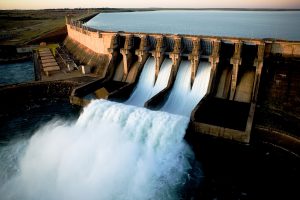Depending on geographic conditions different types of hydro power stations are being used.

Types of hydro power stations
Run-of-river power plants are constructed at rivers, e.g. at weirs or locks. The amount of electricity that can be generated can be calculated from the current of water, the volumetric flow rate and the fall or drop height. The possibility for flexible operation by means of damming or utilization of a reservoir is limited or not possible at all.
Run-of-river hydro power stations continously generate electricity and generally are baseload power plants. Power production is however subject to the river’s water level and fluctuates accordingly.
The work being done is 0 if there is no drop between the inlet and the outlet of the water. This might be the case during flooding, when locks or weirs are opened to allow for water to runoff. If there is no water flow, the power is also zero. This might be the case in times of very low water levels and when the remaining water flow is required for other purposes, such as the shipping industry. Run-of-river power plants generally have full load hours ranging from 4000 to 6000.
In storage power plants, the energy in the flowing water is not directly converted into electricity, but water is stored in a reservoir. In order to drive the turbines, water is channeled from the top of the reservoir to the bottom. A big difference in elevation between the top and the bottom is necessary. Due to the reservoir and its ability to store water, electricity generation is more flexible and can be adjusted to different levels of demand or power prices. Building a reservoir requires huge differences in altitude, therefore storage power plants generally are constructed in mountainous terrain. In order to store sufficient quantities of water big dams are needed.
Pumped-storage power plants can be distinguished from normal storage power plants, as they are able to pump water from a lake at lower altitude up into the reservoir again. They can therefore be used as electricity storage devices. The natural inflow is often less important in pumped-storage power plants.



